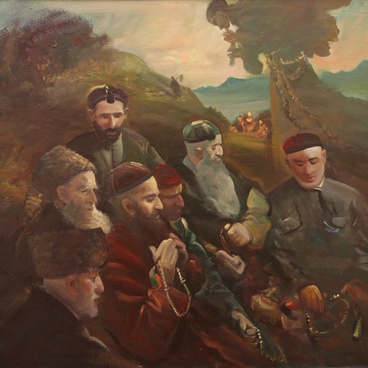‘Still Life Anastasia’ created by artist Georgy Yanakov entered the collection of the State Museum of Fine Arts in 1995. It was transferred from the art gallery of the Cultural Center of the Sunzhensky district. The collection of the Cultural Center was formed in 1988, when more than 30 paintings from the Chechen-Ingush Art Fund were moved to the Sunzhensky district.
As the canvas was constantly moved from collection to collection, original records about it have not been preserved. Unfortunately, there is no information available to the museum about any of the artist’s other paintings, or about the history of ‘Still Life Anastasia’. All the information that the researchers have is the name of the artist — Georgy Yanakov and the time of the creation of the canvas: the 1980s.
The subject matter of the painting is simple: on a white lace tablecloth, the master depicted a ceramic teapot, a kerosene lamp, an open bottle of wine, an open jewelry box with a ball of thread rolled out of it. There are two knitting needles next to it. The master painted pearl beads and a war medal with great care. Most likely, these personal items belonged to the mistress, a photograph of whom stands on the table.
The artist meticulously conveyed all the details. He painted with uncanny fidelity a variety of textures: the transparency of the glass, the matte surface of the ceramics, the different fabrics — from the velvet shawl in the background to the lightness of the thinnest scarf on the right corner of the table.
Georgy Yanakov proved himself as a talented colorist painter. Each fragment of the painting is created by many shades: he painted the petrol lamp in dozens of shades of blue. For the illuminated areas, the artist chose warm tones, and for the deeper shadows — cold ones.
The artist deliberately darkened the background of the painting. Most likely, he used this artistic technique in order to emphasize the elaborate composition of the arrangement on the table. The objects are highlighted in the darkness by a soft flowing light, which adds a poetic charm to the painting, as if the artist was slightly sad about the times when all these things played an important role in the life of the mistress of the house.
The artist’s personal attitude is also indicated in the name of painting. Unfortunately, it is not possible to find out what Anastasia meant for Georgy Yanakov and how her fate turned out.
As the canvas was constantly moved from collection to collection, original records about it have not been preserved. Unfortunately, there is no information available to the museum about any of the artist’s other paintings, or about the history of ‘Still Life Anastasia’. All the information that the researchers have is the name of the artist — Georgy Yanakov and the time of the creation of the canvas: the 1980s.
The subject matter of the painting is simple: on a white lace tablecloth, the master depicted a ceramic teapot, a kerosene lamp, an open bottle of wine, an open jewelry box with a ball of thread rolled out of it. There are two knitting needles next to it. The master painted pearl beads and a war medal with great care. Most likely, these personal items belonged to the mistress, a photograph of whom stands on the table.
The artist meticulously conveyed all the details. He painted with uncanny fidelity a variety of textures: the transparency of the glass, the matte surface of the ceramics, the different fabrics — from the velvet shawl in the background to the lightness of the thinnest scarf on the right corner of the table.
Georgy Yanakov proved himself as a talented colorist painter. Each fragment of the painting is created by many shades: he painted the petrol lamp in dozens of shades of blue. For the illuminated areas, the artist chose warm tones, and for the deeper shadows — cold ones.
The artist deliberately darkened the background of the painting. Most likely, he used this artistic technique in order to emphasize the elaborate composition of the arrangement on the table. The objects are highlighted in the darkness by a soft flowing light, which adds a poetic charm to the painting, as if the artist was slightly sad about the times when all these things played an important role in the life of the mistress of the house.
The artist’s personal attitude is also indicated in the name of painting. Unfortunately, it is not possible to find out what Anastasia meant for Georgy Yanakov and how her fate turned out.



